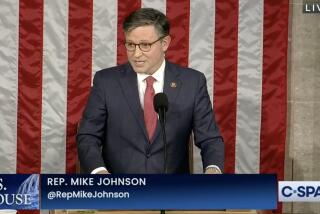Potential Pension Deficit Widened
- Share via
WASHINGTON — The nation’s 50 largest under-funded pension plans have a potential combined shortfall of $21.5 billion, up nearly 50% from the year before, the government’s Pension Benefit Guaranty Corp. said Monday.
The agency, which guarantees pension benefits for nearly 40 million Americans, said the companies on the list were not necessarily in poor financial health or guilty of failing to properly fund their pension plans.
However, the agency added, many of the plans are linked to financially troubled companies and represent a probable loss to the pension insurance fund. The agency said it publicizes the list to make Americans aware, if they work for a company on the list, that their pension plan is under-funded.
The National Assn. of Manufacturers criticized the list, saying it “does little more than create unnecessary anxiety.”
“People that see the list become unnecessarily alarmed . . . while the bulk of the companies have done nothing wrong,” said Chris Bowlin, associate director of the association’s employment benefits division.
Many companies have legitimate reasons for having under-funded plans, he said, such as newly negotiated union contracts and worse-than-expected investment returns.
Last year, the top 50 under-funded pension plans had a potential combined shortfall of $14.2 billion.
The shortfall mushroomed because “pension contributions and investment income fell short of benefit payments and increases,” said James Lockhart, the agency’s executive director.
“Companies have continued to treat PBGC’s guarantee as a subsidy for pension promises they make but cannot afford to meet,” Lockhart said.
Overall, the defined pension benefit system guaranteed by the government is well funded, with more than $1 trillion in assets to back up about $900 billion in liabilities, the agency said.
Here are the 50 companies listed Monday and the size of their potential shortfall if the plans were to close and the PBGC had to guarantee benefits, based on information as of December, 1990.
The firms are listed in order of the worst funding ratio. For instance, LTV Corp. has $3.4 billion in liabilities and $200 million in assets, giving it under-funding of $3.2 billion, or a funding ratio of 6%.
National Steel, at the bottom of the list, has liabilities of $829 million, assets of $779 million and a liability of $50 million for a funding ratio of 94%.
LTV Corp., $3.2 billion; Jesup Group, $106 million; CF&I; Steel, $164 million; Sharon Steel, $150 million; Blaw-Knox, $70 million; Loews, $139 million; Keystone Consolidated Industries, $99 million; American National Can, $429 million; Uniroyal-Goodrich, $434 million; Borg-Warner, $102 million.
New Valley, $304 million; Harnischfeger Industries, $75 million; Bridgestone-Firestone, $231 million; National Intergroup, $270 million; ACF Industries, $59 million; Chrysler, $3.3 billion; Tenneco, $144 million; Paine Webber Group, $47 million; American Financial, $56 million; Carter Hawley Hale Stores, $59 million.
Budd, $178 million; Phelps-Dodge, $51 million; Cyclops Industries, $103 million; Bethlehem Steel, $1.3 billion; Rockwell International, $182 million; White Consolidated Industries, $57 million; Reynolds Metals, $126 million; James River, $59 million; Navistar International, $536 million; UAL, $87 million.
Varity, $57 million; Allegheny Ludlum, $69 million; Northwest Airlines, $78 million; Goodrich, $92 million; General Motors, $7.1 billion; Maxxam, $114 million; Raytheon, $86 million; Weyerhaeuser, $73 million; Westinghouse Electric, $692 million; Honeywell, $60 million.
Kimberly-Clark, $54 million, Trans World Airlines, $190 million; Dana, $76 million; Goodyear Tire & Rubber, $150 million, Deere & Co. $128 million; Armco Steel, $66 million; Allied Signal, $88 million; Armco, $54 million; Textron, $49 million; National Steel, $50 million.
More to Read
Inside the business of entertainment
The Wide Shot brings you news, analysis and insights on everything from streaming wars to production — and what it all means for the future.
You may occasionally receive promotional content from the Los Angeles Times.










